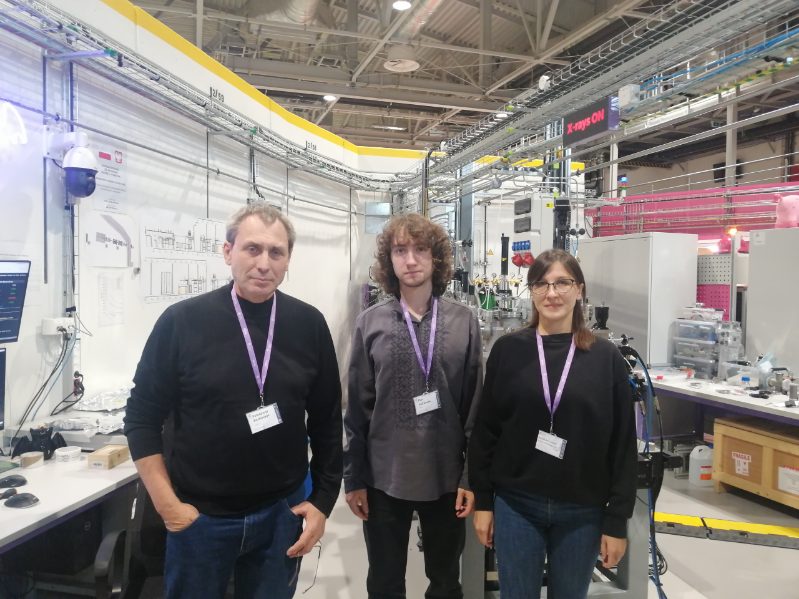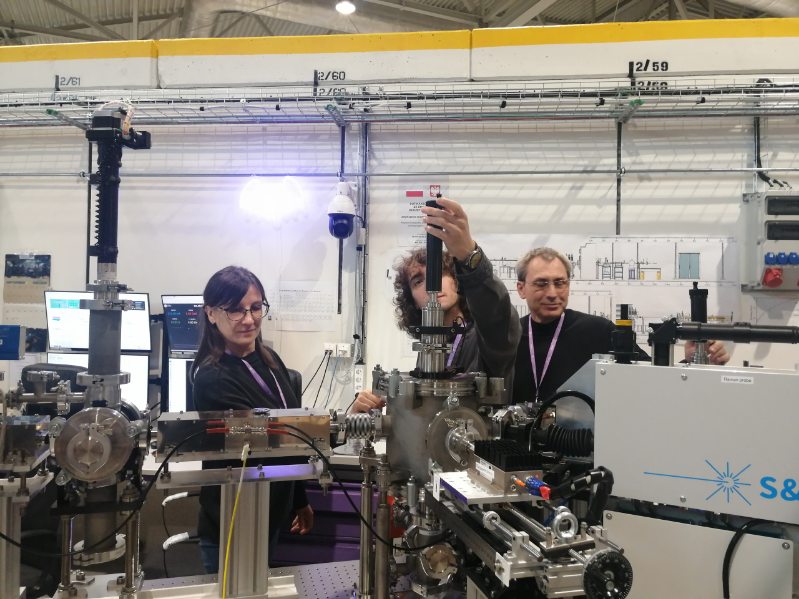A team from the G. V. Kurdyumov Institute for Metal Physics of the National Academy of Sciences of Ukraine — Volodymyr Karbivskyi, Ihor Sukhenko, and Nataliia Kurgan — recently visited the SOLARIS National Synchrotron Radiation Centre in Kraków, Poland, to conduct an experiment at the ASTRA beamline.
Their project, “Probing copper site occupancy and valence in lead apatites via EXAFS and XANES,” was supported through the Transnational Access (TNA) programme of the NEPHEWS project.

According to group leader Volodymyr Karbivskyi, the main goal of the team’s experiment was “to determine the structural positions of copper when copper was added to newly synthesised lead vanadate apatites.”
“We used EXAFS and XANES spectroscopy methods at the ASTRA beamline,” says Karbivskyi. “The main challenge during the experiment? Thanks to the ASTRA beamline scientists, the work was pleasant and straightforward. There were no difficulties that interrupted the process.”
The group was satisfied with obtaining high-quality EXAFS spectra even for samples containing only 1 atomic percent of copper in the apatite matrix – a technically demanding task. “The next steps include processing the EXAFS and XANES spectra and a detailed analysis of the obtained radial distribution functions of atoms, followed by publication,” explains Karbivskyi.
For Ukrainian researchers, access to a modern synchrotron facility like SOLARIS is transformative: “There are no synchrotron centres in Ukraine, so the use of EXAFS and XANES techniques available at SOLARIS has provided opportunities to study the near-order in our systems,” he adds.
Nataliia Kurgan, who has over two decades of experience in X-ray photoelectron spectroscopy, described her visit to SOLARIS as both inspiring and professionally rewarding.
“My visit to SOLARIS left a very positive impression, both in scientific and organizational terms,” she recalls.
“I have been working on an X-ray photoelectron spectrometer at the Center for Shared Usage of Scientific Equipment for over 20 years, and I have always wanted to visit a Synchrotron Center with a high level of technical equipment and modern tools that allow one to carry out complex experimental tasks.”
When the project required XAFS techniques – which are not available in Ukraine – she immediately agreed to join the team. “Thanks to the professionalism and openness of the ASTRA team, which provided comprehensive support at all stages of the work, we were able to fully focus on our tasks.”
Nataliia Kurgan particularly appreciated how responsive the beamline staff were throughout the experiment: “The ASTRA team demonstrated a high level of competence, responding promptly to all requests and helping to optimize the experimental conditions. It was most interesting to see how the beamline works and to understand the possibilities of adapting experimental parameters for in-situ and operando techniques.”
She also highlighted how the TNA NEPHEWS support, which covered travel and accommodation costs, made the visit possible: “The role of TNA NEPHEWS support in simplifying researchers’ access to SOLARIS is very important because it creates comfortable conditions for researchers, which promotes productive work and scientific exchange. Overall, performing experiments at SOLARIS was an important stage of our research and allowed us to obtain results that are critical to our project.”
Ihor Sukhenko played a key role in preparing the beamtime proposal, drawing directly on his experience from the ESR (Early-Stage Researcher) programme at SOLARIS. “I wrote the initial draft of the proposal. The experiment is closely related to my PhD topic, so I was familiar with the problem,” he explains.
His earlier participation in the ESR training programme turned out to be crucial for the success of the application and the experiment: “The ESR training programme had a section dedicated to proposal preparation led by an experienced scientist. We would prepare our presentation of a certain experimental project, and he would give advice on how to shape those ideas into the actual proposal. This helped me a lot. Even though my early summer internship was with a different technique, the experience was profoundly valuable — it makes a big difference whether you are a completely new synchrotron user or not.”
Ihor first came to SOLARIS as part of the ESR internship programme, taking part in an ARPES experiment at the URANOS beamline. The positive experience inspired him to return as a regular user.
“I enjoyed my experience a lot — there were no technical issues, and the staff was very friendly and welcoming. All in all, SOLARIS was the first place we thought of when considering applying for synchrotron beamtime.”
For Ihor, both the ESR and TNA programmes represent essential steps for young scientists entering the world of large-scale research infrastructures:
“ESR is a great opportunity to enter the field of synchrotron-based experiments, especially if your group has no established tradition of those. ESR training and internship can really make up for that. TNA is really helpful for covering the travel and accommodation costs, as these are not always covered by grants or home institutions — like they weren’t in our case. Application and reporting are surprisingly easy. I would certainly recommend applying to those who need it.”
During the ASTRA beamtime, he expanded his expertise in X-ray absorption spectroscopy:
“I was not very well accustomed to XAS, so I learned a lot of important details, especially about sample preparation and measurement regimes. I also received valuable advice from beamline scientists on data interpretation.”
And the highlight of the experiment? – “It was the moment when, after the first measurements, the data started to align with our theoretical models — EXAFS scattering pathways based on simulated crystal structures and XANES edges modelled with DFT. It was even more rewarding given that XAS is a relatively new method for me.”

The team’s visit to SOLARIS highlights how access to advanced research infrastructure through European programmes like NEPHEWS TNA enables scientists from countries without synchrotron facilities to perform world-class research.
“We are deeply grateful to the SOLARIS staff and to the NEPHEWS programme for enabling this opportunity,”
concludes Volodymyr Karbivskyi. “Access to such a modern facility gives our research a new dimension — and builds bridges for future cooperation.”
The NEPHEWS project provides Transnational Access (TNA) opportunities to European synchrotron, neutron and FEL facilities.
Researchers can apply for free beamtime, travel, and accommodation support, fostering collaboration and innovation across Europe in materials science, chemistry, and physics.